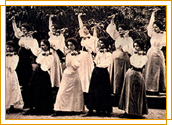Gymnastics and education
The relationship between the world of the game and physical education was an important issue in the 19th century.  On the eve of 1896, gymnastics was considered the educational means that developed man's physical abilities. During that period gymnastics and modern sports were defined and in terms of practice became distinct. On the eve of 1896, gymnastics was considered the educational means that developed man's physical abilities. During that period gymnastics and modern sports were defined and in terms of practice became distinct.
Gymnastics was an older issue that had its origin in Germany. It aimed at the wide public and had an intense educational and military character. The issue of modern sports, on the other hand, was a more recent issue that originated in England. It was addressed to the aristocratic class and its primary objectives were entertainment and competition. However, in 1896, these two issues started to converge.
With the foundation of the Greek state in 1833 gymnastics was included in the school curriculum twice a week. However, teaching of the specific class started much later, in the 1880s. In the 1830s the first Greek book about gymnastics was published, which was then closely related both to physics and moral education of young people. According to G. Pagonas, the writer of this manual, a Greek educator and enthusiastic supporter of gymnastics, the introduction of gymnastics into the curriculum aimed at the intellectual and moral development of young people. It was considered as an exercise for overcoming moral and material obstacles, as well as resolving difficulties and various problems. This specific orientation contributed to making gymnastics useful for the social incorporation of the individual. Through the development of the athletic spirit, the young people learned to obey rules. They also learned the value of discipline and competition, two notions closely related to the modern social reality. The athletic contests were used in order to strengthen the patriotic feelings of those who took part, through comradeship and participation in the same events, obedience to the same rules and the recognition of the same authority. Gymnastics and the athletic contests were also a means for managing and controlling the young people's free time.
|
